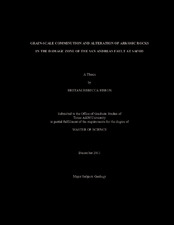| dc.description.abstract | Spot core from the San Andreas Fault Observatory at Depth (SAFOD) borehole provides the opportunity to characterize and quantify damage and mineral alteration of siliciclastics within an active, large-displacement plate-boundary fault zone. Deformed arkosic, coarse-grained, pebbly sandstone, and fine-grained sandstone and siltstone retrieved from 2.55 km depth represent the western damaged zone of the San Andreas Fault, approximately 130 m west of the Southwest Deforming Zone (SDZ). The sandstone is cut by numerous subsidiary faults that display extensive evidence of repeating episodes of compaction, shear, dilation, and cementation. The subsidiary faults are grouped into three size classes: 1) small faults, 1 to 2 mm thick, that record an early stage of fault development, 2) intermediate-size faults, 2 to 3 mm thick, that show cataclastic grain size reduction and flow, extensive cementation, and alteration of host particles, and 3) large subsidiary faults that have cemented cataclastic zones up to 10 mm thick. The cataclasites contain fractured host-rock particles of quartz, oligoclase, and orthoclase, in addition to albite and laumontite produced by syn-deformation alteration reactions. Five structural units are distinguished in the subsidiary fault zones: fractured sandstones, brecciated sandstones, microbreccias, microbreccias within distinct shear zones, and principal slip surfaces. We have quantified the particle size distributions and the particle shape of the host rock mineral phases and the volume fraction of the alteration products for these representative structural units. Shape characteristics vary as a function of shear strain and grain size, with smooth, more circular particles evolving as a result of increasing shear strain. Overall, the particle sizes are consistent with a power law distribution over the particle size range investigated (0.3 µm < d < 400 µm). The exponent (fractal dimension, D) is found to increase with shear strain and volume fraction of laumontite. This overall increase in D and evolution of shape with increasing shear strain reflects a general transition from constrained comminution, active at low shear strains to abrasion processes that dominate at high shear strains. | en |


